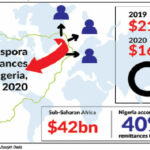
Low-band spectrum will boost the spread of 5G and reduce the gap between urban and rural areas in delivering meaningful connectivity, GSMA has said.
The global association for telcos, in a report titled ‘Socio-Economic Benefits of 5G: The importance of low-band spectrum’, stated that without sufficient low-band spectrum, the digital divide is likely to widen, with people in rural areas not readily enjoying access to 5G.
According to the association, the superior propagation of the low-band spectrum ensures that they are suitable for providing coverage in rural and remote areas, which is important in low- and middle-income countries in Nigeria.
It said, “Without sufficient low-band spectrum, rural citizens can be excluded from the latest digital technologies.
“It is better able to penetrate buildings and serve built-up areas, providing ‘deep’ indoor coverage as well as capacity in urban areas, including locations where people live and work. Depending on the location and residence type, indoor traffic can account for 30–70 per cent of total mobile traffic.”
It noted that low bands, therefore, often account for a greater proportion of traffic than they do capacity.
“Assigning sufficient low-band spectrum is critical to addressing long-term demand for 5G in urban as well as rural areas,” the association added.
According to GSMA, the countries where consumers are more likely to access a 5G signal are also those where they are more likely to connect using low-band frequencies.
It stated that consumers in the US that had a 5G-capable device were more likely to spend most of their time on a 5G network because most of the operators had access to a low-band spectrum.
By the end of 2022, 252 commercial 5G networks in 86 countries around the world had been launched.
Nigeria’s 5G launched on the C-band, which is a mid-band spectrum.
As with other networks, spectrum will determine the speed and coverage of 5G.
According to various reports, while low band spectrum provides the most coverage, it also offers slower speeds and will only be slightly better than 4G.
The low band is used commercially to provide nationwide coverage and privately to help businesses communicate with rural job sites.
Mid-band also offers greater speeds while travelling to great distances.
GSMA added that $3bn in economic value will be added to the Sub-Saharan African region by 2030 though low-band 5G.
It said, “Low-band 5G applications will mostly be used by and benefit the agricultural, mining and retail industries, reflecting the level of economic activity driven by these sectors.
“The wide area coverage enabled by low bands will be particularly important in driving the digital transformation of the agricultural sector, with IoT applications for smart farming and agriculture.”













